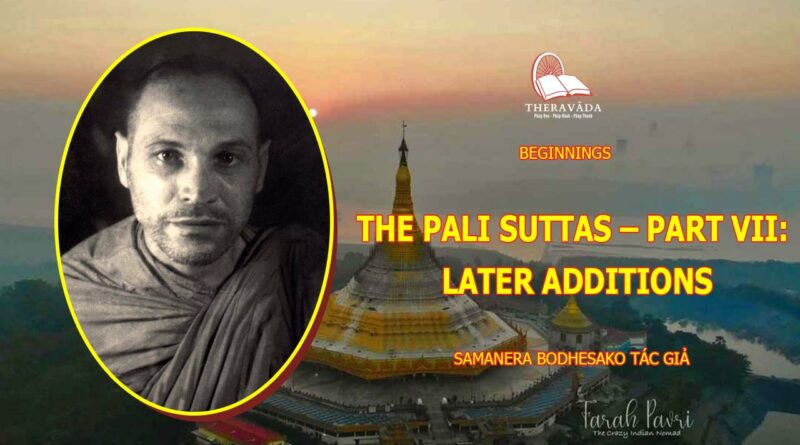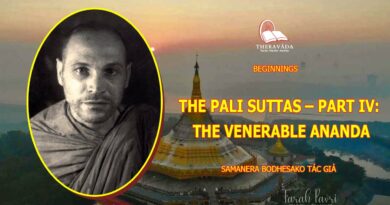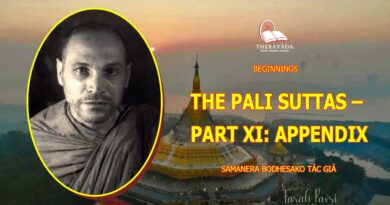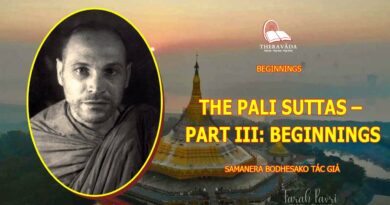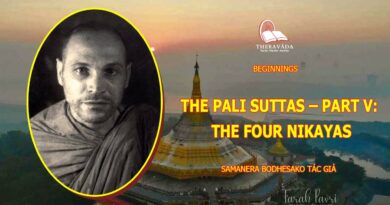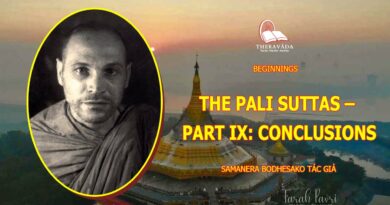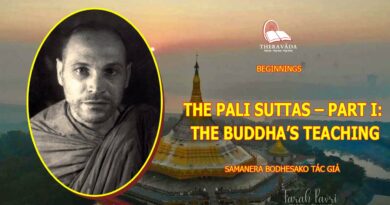BEGINNINGS: THE PALI SUTTAS – PART VII: LATER ADDITIONS
“But how do we know,” it may be asked, “that with the closing of the First Council the Sutta recension that they compiled remained intact, without additions? For if no additions were made later then, true enough, we would have here the actual Teaching of the Buddha. But what grounds are there for accepting this as so?”
A good and important question. The answer being, that we don’t know that “no additions were made later”: quite the contrary, we do know they were made.
The Canon had been open and growing for nearly a half century. For it to be suddenly closed, and for there to be an immediate acceptance of that closure sufficiently widespread for it to be effective, is contrary to reason. Only when the compilation had come to be generally regarded as sacrosanct could the Canon be successfully closed; and such an attitude necessarily develops gradually. And the evidence of the Suttas themselves supports this view. There are, for example, discourses in which Venerable Ananda appears not as the Buddha’s shadow but quite apart from the Buddha. In these discourses he is regarded, except by Venerable Maha Kassapa, as a respected elder; he is called maha-acariya, “great teacher” in A. X,96 (v,198) and in S. XVI,11 (ii,218) he is said to have been touring the Southern Hills leading a great company of monks. It is clear that at least some of these discourses took place after his attendancy on the Buddha had ended, with the decease of his master. Indeed, two of them — Subha Sutta, D. 10, and Gopaka-Moggallana Sutta, M. 108 — state specifically in their introductory material (D. i,204 and M. iii,7) that they took place “not long after” the Buddha’s decease. And there are discourses involving monks other than Venerable Ananda in which the text itself informs us that the conversation took place after the Buddha’s passing away.[27] Nor can we reasonably suppose all these talks to have occurred during the few months between the Buddha’s decease and the convening of the First Council. Some of them may have, but Madhura (of M. 84), for instance, was in Western India, not so far from present-day Delhi but a great distance From Rajagaha, over very bad roads (A. V,220 (iii,256)): even if the discourse itself had originated before the Council met, it could hardly have become known in Rajagaha in such a short time, let alone become popular enough for inclusion in the recension. But even if such is maintained, there still remains the Bakkula Sutta, M. 124 (iii,124-28), in which Venerable Bakkula asserts, at least thirty-three times, that he has been a monk for eighty years.
Now, all accounts agree that the Buddha’s decease took place forty-five years after his awakening. Therefore even if Venerable Bakkula had been ordained very soon after the establishment of the Order,[28] the discourse still had to have taken place at least thirty-five years after the closing of the First Council. And in all likelihood it took place even later than that although Venerable Bakkula could not have been spoken of by the Buddha unless his ordination took place during the Buddha’s lifetime: i.e. the Bakkula Sutta postdates the First Council, but by less than eighty years. We can be quite certain, then, that the First Council did not produce the version of the texts that we now have. But we can be equally certain that the compilation they produced is in no way dramatically different from what we now have. Consider:
If we examine the seven Suttas just referred to, we will notice that they have in common a distinctive feature. Whereas the usual way the discourses begin is: “One time the Exalted One was dwelling at…”[29] these discourses make no mention of where the Buddha dwelt. Rather, they begin: “One time Venerable Ananda (or Venerable Udena, or whoever) was dwelling at…” In other words, by this method they inform us at the very start that they are in fact later additions and are not to be taken as having been part of the First Council’s compilation.[30] There is no attempt to disguise the fact. On the contrary, there is a conscientiousness in its assertion.
And when we look through the Nikayas we find other discourses which follow this same form: “One time Ven. So-and-so was dwelling at…” Although they do not always otherwise declare themselves to be later additions — for once should be enough — yet often we can find further telltale evidence that this is so. Thus for example in the Digha Nikaya aside from the already-mentioned Subha Sutta, there is only one other discourse out of the thirty-four in that collection wherein we are told the dwelling not of the Buddha but of the main individual, Venerable Kumara Kassapa, in this case. This discourse — the Payasi Sutta, D. 23 (ii,316-58) — involves a long discussion between Venerable Kassapa and the chieftain Payasi, mainly on the subject of rebirth. The chieftain presents a series of thought-out reasonings as evidence that there is no rebirth. Venerable Kassapa presents counter-arguments, primarily in the form of elaborate similes,[31] showing the flaws in Payasi’s theses. In the end although Venerable Kassapa does not actually offer any arguments in favour of rebirth, Payasi declares himself to be both convinced and pleased.
Now, on numerous occasions the Buddha declared that for beings constrained by craving there is rebirth (S. XXII,25 (iii,26) etc). He said that he could remember his own past lives (M. 4 (i,22) etc), that he could see the passing on of beings according to their deeds (M. 4 (i,22-3) etc), and that by means of certain mental practices others could develop these abilities (A. X,102 (v,211) etc), and had done so: e.g. the Venerable Maha Moggallana and Anuruddha. But nowhere do the Suttas record the Buddha arguing in favour of rebirth on logical grounds; nor would we expect him to do so for rebirth is not a matter of logic. Yet despite Venerable Kassapa’s assertion that until then he had neither seen nor heard of anyone sharing Payasi’s views, there must have been many sceptics to judge both from the views ascribed by the texts to the various teachers of the day and from the frequency with which the Suttas assert rebirth; and most monks — even among those who had personally achieved complete self-purification — would have had to accept rebirth on the basis of confidence in the Buddha rather than from direct knowledge (see S. XII,70 (ii,122-3), and compare A. VII,54 (iv,78-82)). After the Buddha’s decease, then, there was a strongly felt need for some sort of textual authority to lend support to these monks on the question of rebirth, just as the Madhura Sutta, mentioned earlier, seems to have been included to lend support to the Buddhist teaching of ethical equality between castes. It matters not at all that Venerable Kassapa’s similes are unlikely to convince a modern sceptic: they were appropriate to their time; they filled an existing need. And that need would have been felt most strongly among the reciters and preservers of the long discourses.
The Payasi Sutta, which is obviously the model for the much later Milindapanha, could have been made much shorter — and hence included in any of the other Nikayas — by eliminating extraneous introductory and concluding material and some of the more elaborate similes; so it was not only due to considerations of length that it came to be included in the Digha Nikaya.[32] Rather, questions about rebirth are more apt to be raised by the laity whose goal is to obtain a good rebirth than by monks whose aim is to transcend rebirth entirely, and in fact the arguments of the Payasi Sutta, concerned as they are with reasoning and simile, are more likely to convince a layperson than a practising monk who — questions of relevance aside — might be better convinced by evidence concerned with direct reflection and perception. Of the four Nikayas the Digha is, for reasons we have already noted, the one most directed to the interests of laypeople, thus lending substantiation to the Commentarial suggestion that Venerable Ananda was primarily responsible for this collection. Hence the monks who would most likely seek textual support on the question of rebirth would be the digha-bhanakas, the “reciters of the Digha”. There would have developed among the individuals of the various companies who shared the responsibility for various portions of the long discourses a consensus that the Payasi Sutta, until then a part of the peripheral material known by those reciters but not included in their texts, should be formally included in the Nikaya. Since the Digha is divided into three Vaggas, or sections, each about a volume in length, and since the Payasi Sutta, is now the last discourse of the second Vagga, the responsibility apparently was assigned to or taken up by those who recited the middle portion of the long discourses. However, it was not always the case that later Suttas came to be placed at the end of a Vagga, as the evidence shows.
The discourse makes no claim to being the ipsissima verba of the Buddha. It presents itself as being, in its central portion, a conversation between a certain fairly obscure monk and a certain layman, apparently mentioned nowhere else in the Suttas; there is no reason not to accept it on those terms. It acknowledges itself to be a later addition as the Commentator Dhammapala points out at Vimana Vatthu Commentary, p. 297: indeed, every discourse identified by the traditional commentaries as post-First Council begins, it seems, with the “One time Venerable So-and-so” formula. But it was not a haphazard addition: the mechanism by which the Suttas were passed on necessitated, before the Canon was closed, that additional material could be inserted only when there was a common accord among those who were responsible for a portion of the texts.
Turning now to the Majjhima Nikaya we learn more about the process of adding discourses. Other than those already mentioned there are two discourses in the Majjhima that make no mention of the Buddha’s dwelling place: the Anumana Sutta, M. 15 (i,95-100) and the Maratajjaniya Sutta, M. 50 (i,332-8). Both begin: “One time Venerable Maha Moggallana dwelt in the Bhagga Country…” Since we know from S. XLVII,14 (v,163-5) that both Sariputta and Maha Moggallana predeceased the Buddha, the discourses themselves could not have taken place after the time of the First Council as was evidently the case with the Payasi Sutta; rather they were simply not included in that compilation.[33] But we note that the two Majjhima Suttas have the same venue, and that the Bhagga Country was an out-of-the-way place, at least as measured by the infrequency of its mention in the Suttas.[34] Since Venerable Maha Moggallana and Venerable Sariputta were the two chief disciples of the Buddha, the monks living among the Bhaggas would certainly have remembered the former’s visit to them and would have kept in mind what he had said and done, as part of their local tradition.
There must have been in residence there some companies of majjhima-bhanakas, preserving at least the first third of the Majjhima Nikaya, which today contains 152 Suttas and, like the Digha, is divided into three volume-length Vaggas. They would be the ones to have wished to include these two discourses — all the more precious for having taken place there — in their collection, to raise them from the lower status of local tradition and to afford them additional protection against being lost. When meeting with neighbouring majjhima-bhanakas, as they must have done from time to time, not only to recite together, they successfully convinced their fellow-monks to include these two discourses in their own recitations. Thus, due in effect to local boosterism, the Canon grew. And when we look at the Samyutta Nikaya we find further evidence of this.
Source: Budsas.net

